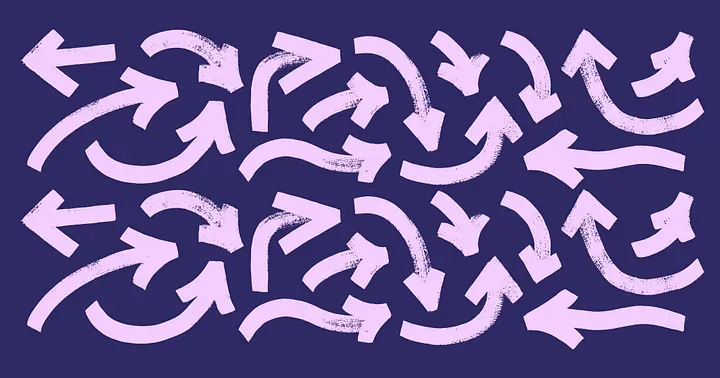If you want to be creative, you can’t be certain.
Purple background with graphics of pink, textured arrows pointing in different directions.
“If you want to be creative, you can’t be certain.” I remember the first time I heard these words. Me and my dad had just sat down to eat lunch at a restaurant at a local hotel in my hometown. I was home visiting for the summer. My dad and I started talking about creativity. The ups and downs of it all. My dad is a musician and writer, and at the time, he was working on his latest music project. I was in the midst of my early career years in the advertising world.
As we started to enjoy the meal, I began to tell my dad about a recent struggle with decision-making. At the time, I felt like, in my work, and in life, I was having a hard time making quick decisions. As a designer in the marketing world, my lack of quick decisions felt like a barrier, and something I had to “unlearn” in order to deliver good work at a pace that fit an industry that is always on the hunt for what’s new and what’s next. As I explained my frustration to my dad, he looked at me and said the words that have become somewhat of a personal motto for me: “if you want to be creative, you can’t be certain.” He went on to explain that creativity is the opposite of certainty. When you’re creating, you’re making something that hasn’t been done before, and to do that, there isn’t a set path with clear yeses and noes. You have to be willing to step into the unknown if you want to be creative.
The conversation was calming and eye-opening, and afterward I started thinking of all the different ways that embracing uncertainty is a super power when it comes to generating creative solutions.
The will to do things that haven’t been done before.
When we’re creating things that have not been done before, uncertainty is inevitable. During my time at IDEO — a global design and innovation firm — our 7 company values guided our work. Number three, “Embracing Ambiguity,” pushed us to think outside the box. “Embracing” doesn’t mean it is easy. Quite the opposite. We often found ourselves in a fog, with a certain level of self-doubt — like imposters.
One of my favorite writers and creatives, Seth Godin, has this blog post where he talks about uncertainty and imposter syndrome. Godin explains that “Everyone who is doing important work is working on something that might not work. And when things might not work, you’re acting as if. And that makes you an imposter.” That is what creativity is all about. Doing important work that might not work. And when the level of self-doubt starts creeping in, know that it’s part of the process, and we can’t create without it.
The courage to pivot
A creative process is about Iterations. We make a first draft or prototype. Then we edit our idea based on feedback. Sometimes, the end solution looks nothing like the starting point. It takes courage to move through the changes and the uncertainty. The uncertainty we feel can give us the courage to pivot — because we’re constantly evaluating our ideas based on needs and markets.
We might be years down the road when we discover that our solutions do more harm than good — or that no one really wants to buy the thing we worked so long on. This is the time we need the courage to look at the facts and change directions. To step into the unknown and try something new.
The time spent may feel like a waste of time, but it’s not. It’s the hard work it took to discover the wrong way. And once we know the wrong way, we’re one step closer to the right one.
The willingness to stay in the question long enough for the dots to connect.
My inability to make decisions is frustrating, but it also allows me to stay in the question longer. I’m not rushing to find a quick fix but rather twisting and turning problems. I often find the need to go back and research some more. To make sure that the path I’ve decided to take is the right one. It wasn’t until I got more comfortable in my role as a designer (I wish I could say that my imposter syndrome went away, but it still surfaces in every project) that I discovered the benefit of this. When it comes to solving problems with creative solutions, we must first spend time figuring out the right problem to solve. Then make sure that the solution we propose is helping more than hurting.
Source
When you stay in the problem longer, you give more time for seemingly unrelated dots to connect. Often, this is what creativity is all about — finding meaning in unrelated things. A phenomenon referred to as apophenia. We’re connecting unrelated dots, and we’re doing it while embracing uncertainty.
I’m in a moment of uncertainty. I’m leaving IDEO because of an office closure in Munich. The discomfort of not knowing what comes next is undeniable. Yet, I am determined to leverage this uncertainty as an advantage, embracing the unknown on the journey to a more creative next chapter.
